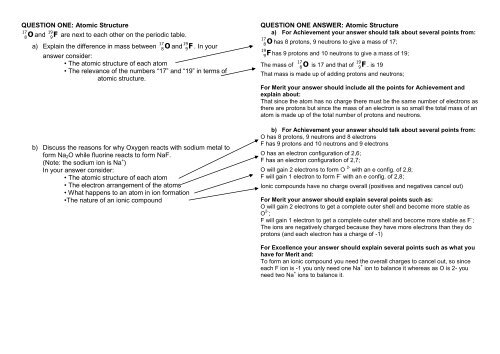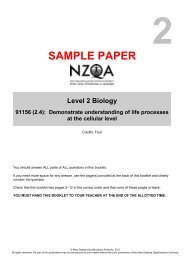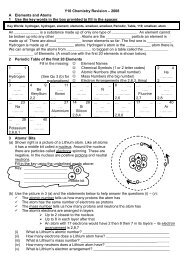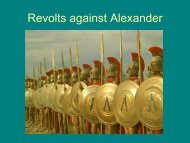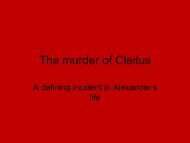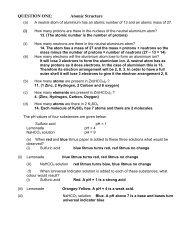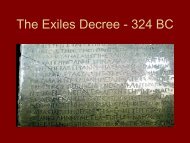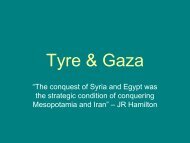Chemistry Answers
Chemistry Answers
Chemistry Answers
You also want an ePaper? Increase the reach of your titles
YUMPU automatically turns print PDFs into web optimized ePapers that Google loves.
QUESTION ONE: Atomic Structure<br />
17 19<br />
8<br />
O and<br />
9<br />
F are next to each other on the periodic table.<br />
17 19<br />
a) Explain the difference in mass between<br />
8<br />
O and<br />
9<br />
F . In your<br />
answer consider:<br />
• The atomic structure of each atom<br />
• The relevance of the numbers “17” and “19” in terms of<br />
atomic structure.<br />
b) Discuss the reasons for why Oxygen reacts with sodium metal to<br />
form Na 2 O while fluorine reacts to form NaF.<br />
(Note: the sodium ion is Na + )<br />
In your answer consider:<br />
• The atomic structure of each atom<br />
• The electron arrangement of the atoms<br />
• What happens to an atom in ion formation<br />
•The nature of an ionic compound<br />
QUESTION ONE ANSWER: Atomic Structure<br />
a) For Achievement your answer should talk about several points from:<br />
17<br />
8<br />
O has 8 protons, 9 neutrons to give a mass of 17;<br />
19<br />
9F<br />
has 9 protons and 10 neutrons to give a mass of 19;<br />
17<br />
19<br />
The mass of<br />
8<br />
O is 17 and that of<br />
9<br />
F . is 19<br />
That mass is made up of adding protons and neutrons;<br />
For Merit your answer should include all the points for Achievement and<br />
explain about:<br />
That since the atom has no charge there must be the same number of electrons as<br />
there are protons but since the mass of an electron is so small the total mass of an<br />
atom is made up of the total number of protons and neutrons.<br />
b) For Achievement your answer should talk about several points from:<br />
O has 8 protons, 9 neutrons and 8 electrons<br />
F has 9 protons and 10 neutrons and 9 electrons<br />
O has an electron configuration of 2,6;<br />
F has an electron configuration of 2,7;<br />
O will gain 2 electrons to form O 2- with an e config. of 2,8;<br />
F will gain 1 electron to form F - with an e config. of 2,8;<br />
Ionic compounds have no charge overall (positives and negatives cancel out)<br />
For Merit your answer should explain several points such as:<br />
O will gain 2 electrons to get a complete outer shell and become more stable as<br />
O 2- ;<br />
F will gain 1 electron to get a complete outer shell and become more stable as F - ;<br />
The ions are negatively charged because they have more electrons than they do<br />
protons (and each electron has a charge of -1)<br />
For Excellence your answer should explain several points such as what you<br />
have for Merit and:<br />
To form an ionic compound you need the overall charges to cancel out, so since<br />
each F ion is -1 you only need one Na + ion to balance it whereas as O is 2- you<br />
need two Na + ions to balance it.
19 17<br />
c) Discuss which you think is more reactive,<br />
9F<br />
or<br />
8<br />
O . In your<br />
answer consider:<br />
• The atomic structure of each atom<br />
• The electron arrangement of the atoms<br />
• The processes involved in making an ion<br />
• The reasons behind these processes<br />
17<br />
O<br />
c) For Achievement your answer should talk about several points from:<br />
8<br />
has 8 protons, 9 neutrons and 8 electrons;<br />
19<br />
9F<br />
has 9 protons and 10 neutrons and 9 electrons;<br />
O has an electron configuration of 2,6;<br />
F has an electron configuration of 2,7;<br />
O will gain 2 electrons to form O 2- with an e config. Of 2,8;<br />
F will gain 1 electron to form F - with an e config. Of 2,8;<br />
Atoms gain or lose electrons to make them more stable (complete outer shells)<br />
For Merit your answer should explain several points such as:<br />
O will gain 2 electrons to get a complete outer shell and become more stable as O<br />
2- ;<br />
F will gain 1 electron to get a complete outer shell and become more stable as F - ;<br />
It is easier to gain 1 electron than to gain 2 so F is more reactive than O;<br />
For Excellence your answer should explain several points such as what you<br />
have for Merit and:<br />
That the extra proton that F has makes it easier for it to attract another electron<br />
(opposites attract) and this makes it more reactive than O.<br />
17<br />
17<br />
d) Explain any differences in mass between<br />
8<br />
O and<br />
8<br />
O<br />
2- . In your<br />
answer consider:<br />
• The atomic structure of each particle<br />
• The changes that occur to an atom when it forms an ion<br />
d) For Achievement your answer should talk about several points from:<br />
17 17<br />
That both<br />
8<br />
O and<br />
8<br />
O<br />
2- have 8 protons, 9 neutrons;<br />
O has 8 electrons while O 2- has 10;<br />
Atoms gain or lose electrons (to get completely full or empty outer shells) to make<br />
them into ions<br />
That mass is made up of adding protons and neutrons<br />
For Merit you should explain several points such as:<br />
That to form an ion the O atom needs to gain 2 electrons to get a complete shell;<br />
While O 2- has 2 more electrons than O, the mass of an electron is so small the<br />
total mass of an atom is made up of the total number of protons and neutrons it<br />
has so O 2- and O have the same mass.
QUESTION TWO: Acids and Bases<br />
You are given four bottles of liquid which have not been labelled. The<br />
bottles are hydrochloric acid, sodium hydroxide, sodium carbonate<br />
(which has a pH of 11) and water. You also have a few pieces of red<br />
and blue litmus paper. Discuss how you could determine which bottle is<br />
which. In your answer consider:<br />
• The properties of Acids and Bases<br />
• Any observations that you would make<br />
• Any reactions you may carry out (including a balanced<br />
chemical, equation)<br />
QUESTION TWO ANSWER: Acids and Bases<br />
For Achievement your answer should talk about 2 – 3 points such as:<br />
Hydrochloric acid has a pH below 7<br />
Sodium hydroxide is a base;<br />
Sodium hydroxide has a pH of above 7;<br />
Sodium carbonate is a base;<br />
Hydrochloric acid will turn blue litmus red and Sodium hydroxide (base) turns red<br />
litmus blue;<br />
Hydrochloric acid will turn blue litmus red and Sodium carbonate turns red litmus<br />
blue;<br />
Water has no effect on red or blue litmus<br />
A word equation such as<br />
Sodium hydroxide + hydrochloric acid → sodium chloride + water<br />
Sodium carbonate + hydrochloric acid → sodium chloride + water + carbon dioxide<br />
For Merit you need to talk about some of the points for Achievement as well<br />
as:<br />
Identifying the acid, the water and what you would see for either base<br />
As both the hydroxide and the carbonate have a pH of above 7 they affect the pH<br />
paper the same you can tell the difference by adding the acid to both liquids – the<br />
one that fizzes is the carbonate<br />
An unbalanced chemical equation<br />
NaOH + HCl → NaCl + H 2 O<br />
Na 2 CO 3 + HCl → NaCl + H 2 O + CO 2<br />
(Already balanced)<br />
For Excellence as for Merit but both equations need to be balanced<br />
Na 2 CO 3 + 2 HCl → 2 NaCl + H 2 O + CO 2<br />
QUESTION THREE: Reactions<br />
There are three mistakes with this equation<br />
LiCO 3 + 2HCl → 2LiCl + CO 3 + H 2<br />
(a) Rewrite the equation so that it is a correctly balanced chemical<br />
equation.<br />
(b) Discuss the reasons for the three changes made to correctly balance<br />
the chemical equation.<br />
QUESTION THREE ANSWER: Reactions<br />
Li 2 CO 3 + 2HCl → 2LiCl + CO 2 + H 2 O<br />
Achievement is making and explaining one correction, Merit is two and<br />
Excellence all three<br />
Points that should be mentioned are that since the reaction is acid + carbonate the<br />
products should be carbon dioxide and water (not CO 3 + H 2 ) and that the formula<br />
for Lithium chloride is Li 2 CO 3 as the Lithium ion is +1 and carbonate is -2 etc
QUESTION FOUR: A Chemical Reaction<br />
A solution of Lead chloride is made by reacting a suitable acid with another<br />
chemical. Pure lead is unreactive so it is not a suitable material.<br />
Discuss how this reaction could be carried out. In your answer you should<br />
refer to<br />
• The type of acid that would be suitable<br />
• Your answer should include an equation for any reactions<br />
described<br />
QUESTION FOUR ANSWER: A Chemical Reaction<br />
For Achievement your answer should talk about 1 – 2 points such as:<br />
The acid you would need is hydrochloric acid;<br />
A word equation such as:<br />
Lead oxide + hydrochloric acid → Lead chloride + water OR<br />
Lead hydroxide + hydrochloric acid → Lead chloride + water OR<br />
Lead carbonate + hydrochloric acid → Lead chloride + carbon dioxide + water<br />
For Merit you should explain several points such as<br />
You need hydrochloric acid as it would give the chloride ions to form Lead chloride;<br />
Because Lead is unreactive you can’t react it with hydrochloric acid so you would<br />
need another lead compound (such as Lead oxide, Lead hydroxide, Lead<br />
carbonate, Lead hydrogen carbonate);<br />
An unbalanced symbol equation such as:<br />
PbO + HCl → PbCl 2 + H 2 O OR<br />
Pb(OH) 2 + HCl → PbCl 2 + H 2 O OR<br />
PbCO 3 + HCl → PbCl 2 + H 2 O + CO 2 OR<br />
Pb(HCO 3 ) 2 + HCl → PbCl 2 + H 2 O + CO 2<br />
For Excellence you need all the explanations from Merit as well as a<br />
balanced symbol equation<br />
PbO + 2 HCl → PbCl 2 + H 2 O<br />
Pb(OH) 2 + 2 HCl → PbCl 2 + 2 H 2 O<br />
PbCO 3 + 2 HCl → PbCl 2 + H 2 O + CO 2<br />
Pb(HCO 3 ) 2 + 2 HCl → PbCl 2 + 2 H 2 O + 2 CO 2
QUESTION FIVE: Atomic Structure<br />
21<br />
19<br />
10Ne<br />
and<br />
9<br />
F are next to each other on the periodic table.<br />
21<br />
19<br />
a) Explain the difference in atomic structure between<br />
10Ne<br />
and<br />
9<br />
F . In<br />
your answer consider:<br />
• The types and numbers of sub-atomic particles present for<br />
each atom<br />
• The relevance of the numbers “21”, “10”, “19” and “9” in<br />
terms of atomic structure.<br />
Diagram(s) may be used to support your discussion.<br />
b) Discuss the reasons for why Neon and Fluorine have very different<br />
chemical properties. (For example Neon does not form any ionic<br />
compounds and fluorine does.)<br />
In your answer consider:<br />
• The atomic structure of each atom<br />
• The electron arrangement of the atoms<br />
• What happens to an atom when it starts to react<br />
• The nature of an ionic compound<br />
QUESTION FIVE ANSWER: Atomic Structure<br />
a) For Achievement your answer should talk about 2 – 3 points from:<br />
21<br />
Ne<br />
10 has 10 protons, 10 electrons and 11 neutrons;<br />
19<br />
9F<br />
has 9 protons, 9 electrons and 10 neutrons;<br />
21<br />
10Ne<br />
has an electron arrangement of 2,8<br />
19<br />
9F<br />
has an electron arrangement of 2,7<br />
21 and 19 are the mass numbers of the atoms<br />
21<br />
19<br />
The mass of 10Ne<br />
is 21 and that of 9<br />
F is 19<br />
10 and 9 are the atomic numbers (proton number) of the atoms<br />
21<br />
19<br />
The atomic number of 10Ne<br />
is 10 and that of 9<br />
F is 9<br />
Extra points<br />
That mass is made up of adding protons and neutrons; Electrons have almost no mass<br />
For Merit your answer should include all the points for Achievement and explain<br />
about:<br />
Ne has a bigger atomic number because it has more protons than F and a bigger mass<br />
number because it has more protons and neutrons than F<br />
That since the atom has no charge there must be the same number of electrons as there<br />
are protons but since the mass of an electron is so small the total mass of an atom is made<br />
up of the total number of protons and neutrons.<br />
b) For Achievement your answer should talk about 3 – 4 points such as:<br />
Neon atoms have 10 protons & 10 electrons; Fluorine atoms have 9 protons & 9 electrons;<br />
Neon has an electron arrangement of 2,8; Fluorine has an electron arrangement of 2,7;<br />
When an atom forms an ion (starts to react) it gains or loses electrons<br />
Neon has a full shell already and doesn’t gain or lose electrons;<br />
Fluorine gains one electron to become 2,8 and F -<br />
Ionic compounds are made of two oppositely charged ions joining together<br />
Ionic compounds have no charge (the charges cancel out)<br />
For Merit you should explain several points such as<br />
Fluorine gains one electron to get a full outer shell / become more stable with a charge of -1;<br />
Neon already has a full outer shell so does not gain/lose electrons and stays with no charge;<br />
Because Neon does not form a charged ion it cannot form an ionic compound as ionic<br />
compounds are made up of two (or more) oppositely charged ions joined together to make a<br />
compound which has no charge;<br />
For Excellence you should explain all the points for Merit and<br />
Because Neon does not form a charged ion it cannot form an ionic compound as ionic<br />
compounds are made up of two (or more) oppositely charged ions joined together to make a<br />
compound which has no charge;<br />
Because fluorine does form a charged ion it can combine with an oppositely charged ion to<br />
form an ionic compound (which has no charge)
QUESTION SIX: Isotopes<br />
Lithium atoms can exist in different forms called isotopes. Two of these<br />
isotopes are Lithium-6 ( 6 3<br />
Li ) and Lithium-7 ( 7 3<br />
Li).<br />
(a)<br />
(b)<br />
Explain why 3 6 Li and 3 7 Li are both neutral atoms. In your answer, you<br />
should fully describe their atomic structure and state their electron<br />
configuration.<br />
Berylium can exist as in the form of beryllium-7 ( 4 7 Be).<br />
Discuss how the mass of 4 7 Be compares with 3 6 Li AND 3 7 Li. In your<br />
answer, you should:<br />
consider the atomic structure of each atom<br />
consider the meaning of the numbers ‘6’ and ‘7’ in terms of the<br />
atomic structures<br />
explain how the particles within an atom contribute to its overall<br />
mass.<br />
QUESTION SIX ANSWER: Isotopes<br />
For Achievement your answer should talk about 4 points such as:<br />
in (a) gives atomic structure of 6 Li and 7 Li: 3 6 Li – 3p, 3n, 3e 3 7 Li – 3p, 4n. 3e<br />
in (a) gives electron configuration 2, 1<br />
in (a) recognises that both 6 Li and 7 Li have equal numbers of protons and<br />
electrons<br />
in (b) gives the atomic structure of 7 Be: 4 7 Be – 4p, 3n, 4e<br />
in (b) recognises that 6 and 7 refer to total mass of element(s)<br />
in (b) recognises that the mass is found by adding up the protons and<br />
neutrons.<br />
For Merit you should explain three points such as<br />
in (a) explains why 6 Li and 7 Li are neutral. E.g. Both 3 6 Li and 3 7 Li have equal<br />
numbers of protons and electrons, ie 3p and 3e. An atom is neutral when it<br />
has equal numbers of protons and electrons.<br />
Diagram of Lithium isotopes acceptable as evidence<br />
in (b) explains how the particles contribute to the overall mass<br />
E.g. Overall mass of an atom is made up of protons and neutrons, as the<br />
mass of electrons is negligible.<br />
in (b) explains why 7 Be and 7 Li have the same atomic mass (same total<br />
number of protons and neutrons)<br />
in (b) explains why 7 Be is heavier than 6 Li (extra proton).<br />
For Excellence you should explain all the points for Merit and<br />
In (b) compares the mass of 7 Be to both 7 Li and 6 Li and explains the<br />
comparison of the masses by referring to the particles which contribute to<br />
the overall mass. E.g.<br />
7<br />
Be will have the same atomic mass as 7 3<br />
Li because the total number of<br />
4<br />
protons and neutrons is the same AND 4 7 Be is heavier than 3 6 Li as it has<br />
one more proton.
QUESTION SEVEN: Atomic Structure<br />
35<br />
19<br />
Chlorine (<br />
17<br />
Cl) is directly below fluorine (<br />
9<br />
F ) on the periodic<br />
table<br />
35<br />
19<br />
(a) Explain why<br />
17<br />
Cl and<br />
9<br />
F are neutral atoms. You should<br />
describe their atomic structure, and state their electron<br />
configuration.<br />
Diagram(s) may be used to support your discussion.<br />
(b) Both chlorine and fluorine react easily to form compounds.<br />
Discuss the type of ions that chlorine and fluorine form and<br />
the reasons for their high reactivity.<br />
In your answer consider:<br />
• The atomic structure of each atom and their electron<br />
configuration<br />
• What happens to an atom in ion formation<br />
• The link between their structure and their reactivity<br />
QUESTION SEVEN ANSWER: Atomic Structure<br />
(a) For Achievement you should talk about 2 correct statements:<br />
35<br />
19<br />
35<br />
17<br />
Cl : 17 protons, 18 neutrons OR<br />
9<br />
F : 9 protons, 10 neutrons OR Cl<br />
19<br />
config. 2,8,7 OR<br />
9<br />
F e-config. 2,7 OR<br />
An atom is neutral when it has the same number of protons and electrons<br />
OR Relevant labelled diagram<br />
17<br />
e-<br />
For Merit you should give the Atomic structure and electron configuration<br />
for both PLUS an explanation of why they are neutral<br />
35<br />
Cl<br />
17<br />
: 17 protons, 18 neutrons, e-config. 2,8,7<br />
19<br />
F<br />
9<br />
: 9 protons, 8 neutrons, e-config. 2,7<br />
AND<br />
35<br />
19<br />
17<br />
Cl and<br />
9<br />
F are both neutral because they each contain equal numbers of<br />
protons and electrons<br />
(b) For Achievement you should talk about 2 correct statements:<br />
35<br />
17<br />
Cl : 17 electrons, e-config. 2,8,7 OR Cl - 19<br />
e-config = 2,8,8 OR F<br />
electrons, e-config. 2,7 OR F - e-config. 2,8<br />
9<br />
9<br />
For Merit you should give one correct explanation<br />
Cl forms a -1 ion because it now has 18 electrons / negative charges and only 17<br />
positive charges (or 1 more electron than proton)<br />
OR<br />
F forms a -1 ion because it now has 10 electrons / negative charges and only 9<br />
positive charges (or 1 more electron than proton)<br />
OR<br />
Cl gains an electron to become stable / get complete outer shell / form Cl - / -1 ion<br />
OR<br />
F gains an electron to become stable / get complete outer shell / form F - / -1 ion<br />
OR<br />
Cl & F are highly reactive because it is easy to gain one extra electron<br />
For Excellence you should discus both elements and how their ability to<br />
attract electrons leads to high reactivity<br />
Cl and F form -1 ions because they now have 1 more electron / negative charge<br />
than they do protons / negative charges<br />
AND<br />
They are highly reactive because it is easy to gain one extra electron
QUESTION EIGHT: Atomic Structure<br />
Fluorine is a colourless gas that is rarely found as an element. It is more<br />
likely to be found as the fluoride ion in a range of compounds, for example<br />
those in toothpaste such as sodium fluoride or calcium fluoride.<br />
(a)<br />
(b)<br />
19<br />
9<br />
F<br />
Discuss how a Fluorine atom becomes a Fluoride ion. Include:<br />
the number of each of the sub-atomic particles in the atom<br />
and ion, and give the charge on these particles.<br />
an explanation why the Fluorine atom is much less common<br />
than its compounds.<br />
Labelled diagram(s) may be used to support your discussion.<br />
Give the ionic formulae for sodium fluoride and calcium<br />
fluoride and explain why these two compounds have different<br />
numbers of atoms.<br />
QUESTION EIGHT ANSWERS: Atomic Structure<br />
(a) For Achievement you should talk about 2 correct statements:<br />
Correct statement or information from 2 columns or rows of table<br />
charge atom ion<br />
P pos 9 9<br />
N neutral 10 10<br />
E neg 9 10<br />
OR same info from diagrams OR<br />
Atom is less common because it is unstable and easily forms compounds as an ion OR<br />
Atom gains 1e to become ion with 1- charge<br />
OR F is reactive as it is easy for it to gain 1 electron<br />
For Merit you should give one correct explanation of all particles and charges OR<br />
why atom is uncommon. Eg:<br />
The number of protons, 9 (positive charges) and neutrons, 10 (no charge) doesn’t change<br />
between the atom and ion. Only the electron number changes from 9 to 10 (negative<br />
charges) when 1 more is added to the valence shell to give a full shell of 8 and a charge of<br />
1-. OR<br />
The atom is not common as F is an unstable element that readily forms compounds<br />
because it needs only 1 e to have a complete outer shell and be more stable<br />
For Excellence you should give a discussion of particles and charges AND why atom<br />
is uncommon Eg:<br />
The number of protons, 9 (positive charges) and neutrons, 10 (no charge), doesn’t change<br />
between the atom and ion (ie. the nucleus stays the same). Only the electron number<br />
changes from 9 to 10 when 1 more is added to the valence shell to give a full shell of 8 and<br />
a charge of 1- due to one extra negative charge.<br />
The atom is not common as F is an unstable element (from the halogen group) that readily<br />
forms ionic compounds because it has 7 valence electrons and only needs one to form a full<br />
and stable valence shell. It will form ionic compounds readily with most common metals<br />
which will contribute the extra electron to form the ion, so F is generally found as part of a<br />
compound.<br />
(b) For Achievement you should give both correct formulae<br />
NaF CaF 2<br />
For Merit you should give Correct explanation and formulae<br />
NaF CaF 2 AND<br />
Na forms a 1+ ion and F a 1- ion, so one atom of each combines to give a neutral<br />
compound / overall charge of 0<br />
AND<br />
Ca forms a 2+ ion and F a 1- ion, so 2 ions of F are needed to each take an electron from<br />
Ca to give a neutral compound / overall charge of 0<br />
OR similar
QUESTION NINE: Acids and Bases<br />
Antacid tablets are taken to relieve the pain of a sore stomach. They work<br />
by reducing the amount of hydrochloric acid in the stomach. The acid then<br />
cannot burn the lining of the stomach and cause pain. There are many<br />
chemicals that can be used in antacid tablets.<br />
Two that are commonly used are Magnesium hydroxide OR Aluminium<br />
carbonate.<br />
QUESTION NINE ANSWER:<br />
Acids and Bases<br />
(a) For Achievement you should talk about 2 correct statements:<br />
Both work to react with the acid in the stomach, neutralising some of it / converting<br />
to neutral substances<br />
OR<br />
Mg(OH) 2 – observe solid disappearing / heat produced / clear solution results<br />
OR<br />
Al 2 (CO 3 ) 3 – observe fizzing as CO 2 gas produced / solid disappears / heat<br />
produced / clear solution produced<br />
OR<br />
Both substances will increase the pH of the acid<br />
(a)<br />
(b)<br />
Explain how EACH of these substances reacts with hydrochloric<br />
acid to reduce the amount of acid in the stomach, and therefore<br />
relieve pain.<br />
Include:<br />
a comparison of what would be observed if:<br />
- Magnesium hydroxide was added to hydrochloric acid in<br />
a test tube.<br />
- Aluminium carbonate was added to hydrochloric acid in<br />
a test tube.<br />
an explanation on the effect of either substance on the pH of<br />
the acid.<br />
Write word equations AND balanced chemical equations for<br />
each substance mentioned in Part (a), (magnesium hydroxide and<br />
aluminium carbonate), reacting with hydrochloric acid.<br />
For Merit you should give one correct explanation<br />
Pain is relieved because each substance reacts with the HCl to produce neutral<br />
salts, which have a neutral pH, so increase the stomach pH<br />
(or similar but relating to test tubes instead)<br />
OR<br />
Compares the observations - Mg(OH) 2 will simply disappear (to leave a clear<br />
solution), but Al 2 (CO 3 ) 3 will fizz, producing a gas (CO 2 )<br />
(b) For Achievement you should give one correct word equation<br />
Magnesium hydroxide + hydrochloric acid magnesium chloride +water OR<br />
Aluminium carbonate + hydrochloric acid aluminium chloride +water + carbon<br />
dioxide<br />
For Merit you should give ONE correct word equation AND ONE correct<br />
symbol equation (does not have to be balanced)<br />
Magnesium hydroxide + hydrochloric acid magnesium chloride +water<br />
AND Mg(OH) 2 + 2HCl MgCl 2 + 2H 2 O<br />
OR<br />
Aluminium carbonate + hydrochloric acid aluminium chloride +water + carbon<br />
dioxide AND Al 2 (CO 3 ) 3 + 6HCl 2AlCl 3 + 3H 2 O + 3CO 2<br />
For Excellence you should give TWO correct balanced chemical equations<br />
Mg(OH) 2 + 2HCl MgCl 2 + 2H 2 O<br />
AND<br />
Al 2 (CO 3 ) 3 + 6HCl 2AlCl 3 + 3H 2 O + 3CO 2
QUESTION TEN: ATOMIC STRUCTURE<br />
(a) Use a periodic table to copy and complete the following table:<br />
(b) Explain how the elements in the table are common to each<br />
other and include why they form ions and the type of ions they form<br />
(c) Choose one of the elements from the table in (a) and discuss<br />
what happens when it bonds with chlorine. Include in your answer<br />
<br />
<br />
Name Symbol No. of<br />
electrons<br />
Sodium 11<br />
Electron<br />
arrangement<br />
Ca 2,8,8,2<br />
Magnesium 2,8,2<br />
Al 13<br />
the type of bonding it undergoes with chlorine<br />
the nature and formula of the final compound formed<br />
ANSWER TEN: ATOMIC STRUCTURE<br />
a)<br />
Name Symbol No. of<br />
electrons<br />
Electron<br />
arrangement<br />
Sodium Na 11 2,8,1<br />
Calcium Ca 20 2,8,8,2<br />
Magnesium Mg 12 2,8,2<br />
Aluminium Al 13 2,8,3<br />
b) Identifies how the elements are common to each other<br />
All are metals or all want to lose electrons to become ions<br />
Why they form ions<br />
They form ions by losing electrons to have a full outer shell and become stable.<br />
Since they have lost electrons all the metal ions will be positive (as they now have<br />
more protons than electrons and protons have a positive charge and electrons a<br />
negative charge)<br />
c) Type of bonding one undergoes with chlorine<br />
It undergoes ionic bonding with chlorine as they lose their valence electrons, they<br />
can give/donate these to non-metals which need to gain these to have a full outer<br />
shell (become more stable).<br />
This leads to a final compound with no charge. (Because total numbers of protons<br />
and electrons are unchanged / charges cancel out)<br />
NaCl / CaCl 2 / MgCl 2 / AlCl 3<br />
For Achievement your answer should have THREE correct statements.<br />
a) Completes 4 parts of the table<br />
b) Identifies how they are common to each other (1 relevant point)<br />
Identifies they form ions by losing electrons<br />
c) Identifies ionic bonding with chlorine<br />
Gives correct ionic compound formula<br />
For Merit your answer should have THREE correct out of:<br />
a) Completes all the table<br />
b) Identifies at least one way they are common to each other<br />
Explains why they form ions<br />
c) Identifies ionic bonding with chlorine and partially explains it<br />
For Excellence your answer should have TWO correct out of:<br />
b) Discusses why they form ions and the type of ion that is formed (positive)<br />
and must talk about both proton and electron charges and overall numbers<br />
c) Discusses ionic bonding and what happens to the electrons from both the<br />
metal and chlorine.<br />
Discussion of why final compound has no charge
QUESTION ELEVEN: ISOTOPES<br />
Chlorine has two common isotopes 35 Cl, and 37 Cl.<br />
Discuss these two isotopes. In your discussion, include:<br />
a definition for an isotope<br />
the atomic structure of each atom<br />
consider the meaning of the numbers ‘35’ and ‘37’ in terms of<br />
the atomic structures<br />
explain how the particles within an atom contribute to its<br />
overall mass<br />
Whether the two isotopes behave the same chemically (that<br />
is in chemical reactions)<br />
QUESTION ELEVEN ANSWER: ISOTOPES<br />
Definition of an isotope<br />
An isotope is an atom of the same element but has different numbers of neutrons/<br />
same atomic number but different mass number<br />
Atomic structure:<br />
35 Cl, – 17p, 18n, 17e<br />
37 Cl – 17p, 20n. 17e<br />
Electron configuration:<br />
Both: 2,8,7 so both form -1 ions<br />
Relevance of numbers:<br />
35 and 37 refer to the total mass / number of p + n.<br />
Explanation of mass:<br />
Overall mass of an atom is made up of protons and neutrons, as the mass of<br />
electrons is negligible.<br />
Chemical Reactivity:<br />
Since isotopes have the same number of protons and electrons, they have the<br />
same electron arrangement and will both gain 1 electron (to gain a complete outer<br />
shell and become stable) so both form -1 ions and therefore both react the same.<br />
For Achievement your answer should have FOUR correct out of:<br />
Defines an isotope<br />
gives atomic structure of 35 Cl and 37 C<br />
gives electron configuration<br />
recognises that 35 and 37 refer to total mass of element(s)<br />
recognises that the mass is found by adding up the protons and neutrons.<br />
Electrons have negligible mass<br />
Both isotopes react the same<br />
For Merit your answer should have TWO explanations out of:<br />
<br />
<br />
<br />
explains how the particles contribute to the overall mass<br />
explains why both isotopes form -1 ions (gaining electron to become stable)<br />
explains why 35 Cl and 37 Cl have the same chemical reactivity as they both<br />
have the same number of protons and electrons / electron arrangements<br />
For Excellence your answer should have everything including:<br />
links changing electron arrangement (stability) to proton and electron<br />
numbers to give a -1 charge<br />
links together the isotopes having the same reactivity to the electron<br />
arrangement changing to form ions with the same charge
QUESTION TWELVE: ACID / BASE REACTIONS<br />
Solid pellets of sodium hydroxide, NaOH, are sold as drain<br />
unblocker. On the side of the container they have the stickers as<br />
shown below.<br />
QUESTION TWELVE ANSWER: ACID / BASE REACTIONS<br />
a) Estimate of approx. pH: 12-14<br />
b) Colour sodium hydroxide would turn two indicators<br />
It would turn red litmus blue<br />
Universal indicator dark blue or purple<br />
Phenolphthalein pink<br />
c) The hydroxide ions in the base (NaOH) react with the H+ ions in the acid<br />
to form water (a neutral substance)<br />
Corrosive<br />
It can also be used if there has been an acid spill. The pellets can be<br />
added to the acid (e.g. sulfuric acid) until the acid is no longer<br />
dangerous.<br />
Discuss the chemistry of sodium hydroxide which enables it to be<br />
used to deal with acid spills and include:<br />
(a)<br />
The approximate pH of the sodium hydroxide pellets in<br />
water<br />
Word equation:<br />
Sodium hydroxide + sulfuric acid → sodium sulfate + water<br />
Symbol equation:<br />
H 2 SO 4 + 2NaOH → Na 2 SO 4 + 2H 2 O<br />
For Achievement your answer should have THREE correct out of:<br />
Approx pH of sodium hydroxide<br />
Colour it would turn at least one indicator<br />
Bases neutralises acids<br />
The pH of the acid is raised (towards 7 - neutral)<br />
word equation<br />
(b)<br />
(c)<br />
The colour the sodium hydroxide would turn TWO indicators:<br />
(make sure you name the indicators)<br />
Discussion for why sodium hydroxide can be used to deal with<br />
the effects of spilt sulfuric acid.<br />
Give word and balanced symbol equations for any reaction<br />
referred to.<br />
For Merit your answer should have TWO correct out of:<br />
Colour it would turn two indicators<br />
Hydroxide ions in base neutralise H + ions in acid (to form water)<br />
Unbalanced symbol equation<br />
For Excellence your answer should have a) and b) correct as well as<br />
Hydroxide ions in base neutralise H + ions in acid (to form water) this raises the<br />
pH to safe levels (7)<br />
Balanced symbol equation
QUESTION THIRTEEN: REACTIONS AND REACTION RATES<br />
Sam is trying to make carbon dioxide gas to see if it really will put<br />
out a flame. He has been given a chemistry set with 2 bottles of<br />
different concentrations of hydrochloric acid, HCl, and small solid<br />
cubes of baking soda, NaHCO 3 . He wants to make lots of carbon<br />
dioxide in the shortest amount of time.<br />
a) Discuss TWO ways he could speed up the rate of reaction<br />
and how this relates to the collision theory.<br />
b) Write a word equation for the reaction of hydrochloric acid,<br />
HCl and baking soda (sodium hydrogen carbonate) NaHCO 3 and a<br />
balanced symbol equation:<br />
c) Discuss how Sam could produce carbon dioxide gas and<br />
zinc nitrate and include:<br />
the chemicals he would need (different to the ones used in (a)<br />
and (b))<br />
a word and balanced symbol equation for this<br />
a test which would prove he has produced carbon dioxide gas<br />
QUESTION THIRTEEN ANSWER: REACTIONS AND REACTION<br />
RATES<br />
a) Ways to speed up reaction rate.<br />
1. Use the greater conc. of hydrochloric acid. This would mean that there are more<br />
acid particles in solution which could come into contact with the baking soda,<br />
creating more CO 2 quickly<br />
2. Crush up the baking soda. This would increase the surface area for the acid<br />
particles to come into contact with, speeding up the rate of reaction.<br />
3. Heat the mixture up which would cause all the particles to move faster. As they<br />
move faster the collision rate should increase thereby increasing the production<br />
rate of CO 2 .<br />
b) Word equation<br />
Hydrochloric acid + sodium hydrogen carbonate → sodium chloride +<br />
carbon dioxide + water<br />
Symbol equation HCl + NaHCO 3 → NaCl + H 2 O + CO 2<br />
c) Another way to produce carbon dioxide<br />
Use nitric acid on zinc carbonate, (or zinc hydrogen carbonate)<br />
Word equation<br />
e.g. Zinc carbonate + nitric acid → Zinc nitrate + carbon dioxide + water<br />
Symbol equation<br />
e.g. ZnCO 3 + 2HNO 3 → Zn (NO 3 ) 2 + CO 2 + H 2 O<br />
Test for carbon dioxide: Limewater (Ca(OH) 2 )- the solution should go cloudy/ milky<br />
if carbon dioxide is present<br />
For Achievement your answer should have:<br />
Listing any 2 ways to increase the rate; OR Any two of:<br />
Either word equation (b or c)<br />
Identifying nitric acid would be needed<br />
Listing another way to make carbon dioxide<br />
Stating the test for carbon dioxide<br />
For Merit your answer should have TWO correct out of:<br />
Explaining any 2 ways to speed up the rate.<br />
Either symbol equation correct (b or c) (not balanced)<br />
Explaining how to make carbon dioxide and zinc nitrate AND the positive test<br />
for carbon dioxide<br />
For Excellence your answer should have both of:<br />
Discussing any 2 ways to speed up the rate of reaction and linking this to<br />
collision theory.<br />
Both symbol equations correct and balanced (note: (b) fully balanced at Merit)
QUESTION FOURTEEN: RATES OF REACTION<br />
Marble chips (calcium carbonate) are added to dilute hydrochloric<br />
acid in a conical flask. The flask is connected to an inverted<br />
measuring cylinder in a trough of water, as shown in the diagram<br />
below.<br />
The volume of gas produced is measured over a few minutes, and<br />
the results used to sketch a graph.<br />
a) The slope of the graph is steep at the beginning and then<br />
levels off over time. Explain what is happening, in terms of<br />
particles, during the reaction.<br />
Continued over page<br />
QUESTION FOURTEEN ANSWER: RATES OF REACTION<br />
a) Explanation of levelling of graph:<br />
As the reactant particles collide, they are converted into product particles. Initially<br />
many gas molecules are produced, but as the reaction proceeds there are fewer<br />
and fewer reactant particles available to collide, so the volume of gas produced<br />
decreases and eventually no gas is produced. (Most likely the supply of acid / H +<br />
ions in the solution will be exhausted before the marble chips disappear.)<br />
b) Completing a word equation: Hydrochloric acid + calcium carbonate <br />
calcium chloride + water + carbon dioxide<br />
Completing a symbol equation: 2HCl + CaCO 3 CaCl 2 + H 2 O + CO 2<br />
c) Comparison of rates of reaction:<br />
The reaction rate will be faster with the powdered marble than when the chips<br />
were used. More gas will be produced each minute. The reaction itself will be<br />
completed in a shorter period of time.<br />
Explanation of effect:<br />
There are more reactant particles immediately available to react because the<br />
surface area of the powder is greater than that of the chip. There is greater<br />
exposure of the marble particles so there are more available for the acid particles /<br />
hydrogen ions / H + ions to collide with.<br />
This means there will be more (effective) collisions per second / more frequent<br />
collisions between the acid particles and the ions in the calcium carbonate powder,<br />
leading to an increase in the rate of the reaction and the reaction will be completed<br />
sooner.<br />
For Achievement your answer should have THREE correct out of:<br />
in (a), states that the decrease in gas production is due to the reaction slowing<br />
down<br />
in (b), completes the word equation correctly<br />
in (c), states that the rate of reaction will increase / the reaction will be faster<br />
in (c), identifies there is a greater / increased / larger surface area of marble.<br />
For Merit your answer should have TWO correct out of:<br />
in (a), explains why the reactions slow down in terms of the availability of<br />
particles for collisions<br />
in (b), completes the balanced symbol equation correctly<br />
in (c), explains how increasing the surface area of the marble would speed up<br />
the reaction (more area for collisions)<br />
For Excellence your answer should have both of:<br />
in (a), explains why the reaction slows down by relating the decreasing<br />
frequency of particle collisions with the decreasing amount of reactant particles<br />
in (c), explains why the reaction proceeds at a faster rate by relating the<br />
increasing frequency of particle collisions to the increased exposure of<br />
reactant particles on the surface of the powdered marble.
) Copy and complete the word and symbol equations below to<br />
show the reaction in the experiment.<br />
Word equation:<br />
Balanced symbol equation:<br />
c) The experiment is repeated but this time the same mass of<br />
marble chips is crushed into a powder before it is added to<br />
the flask.<br />
Discuss the effect on the reaction rate of using powdered<br />
marble with hydrochloric acid compared with using marble<br />
chips. In your answer, you should:<br />
compare the rates of reaction<br />
explain the differences in the reaction rate by discussing how<br />
crushing the marble chips affects the number of particle<br />
collisions.


